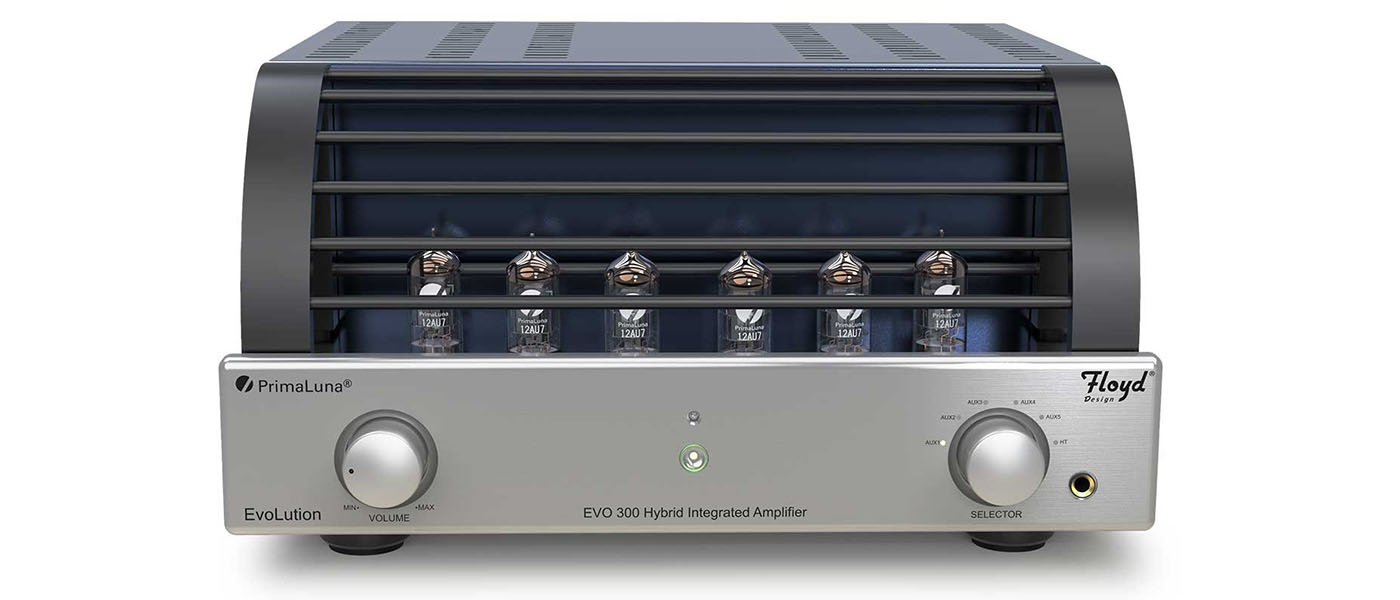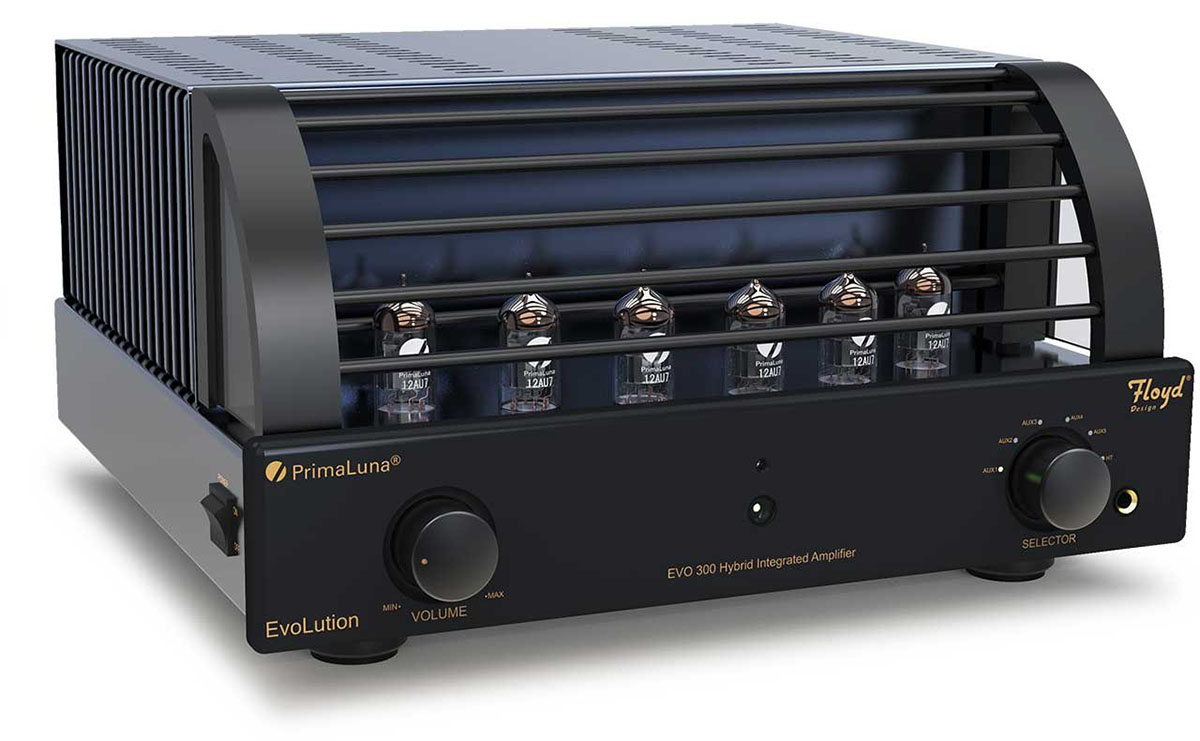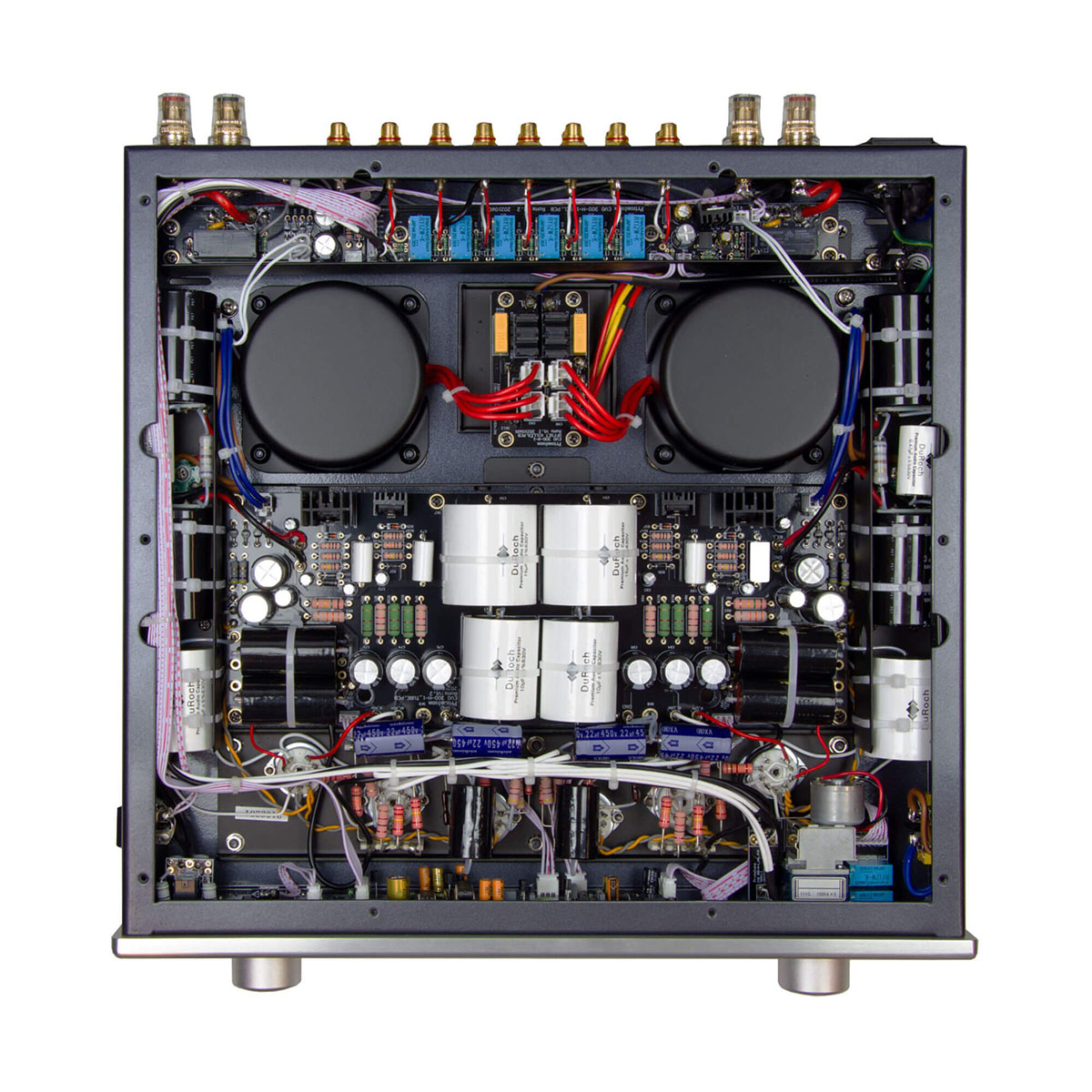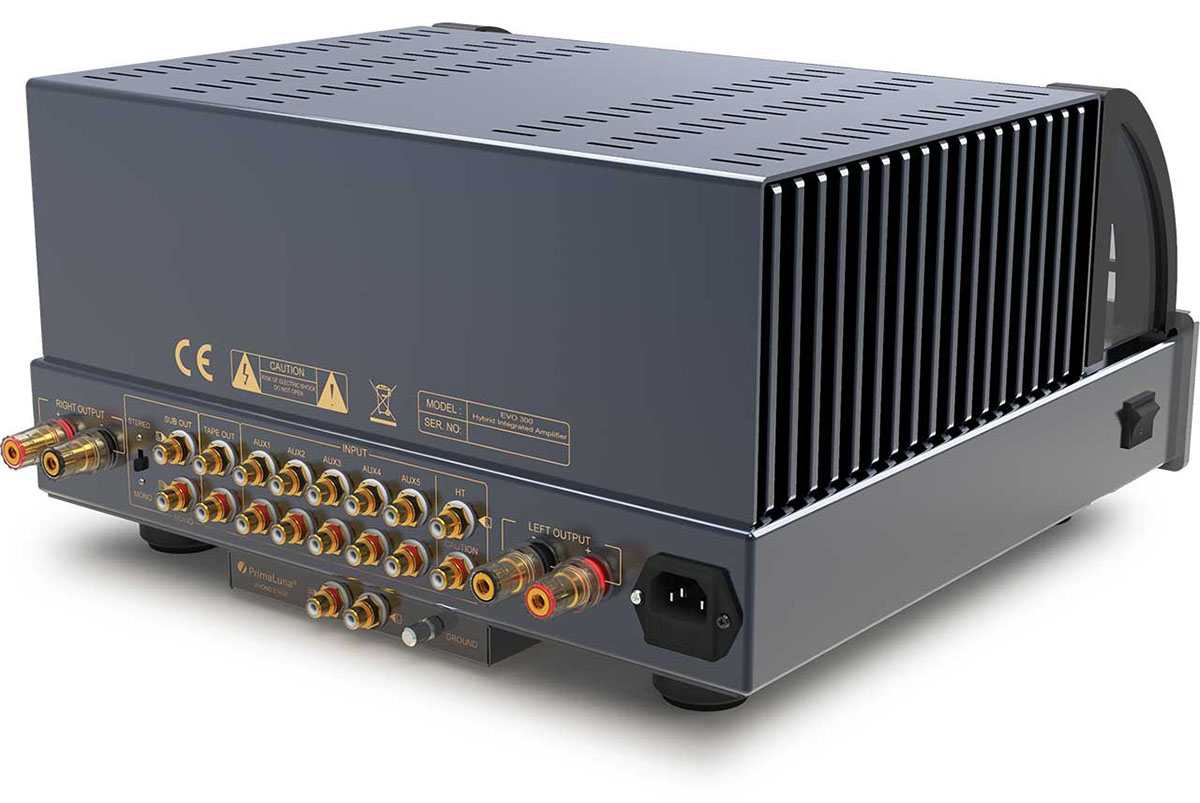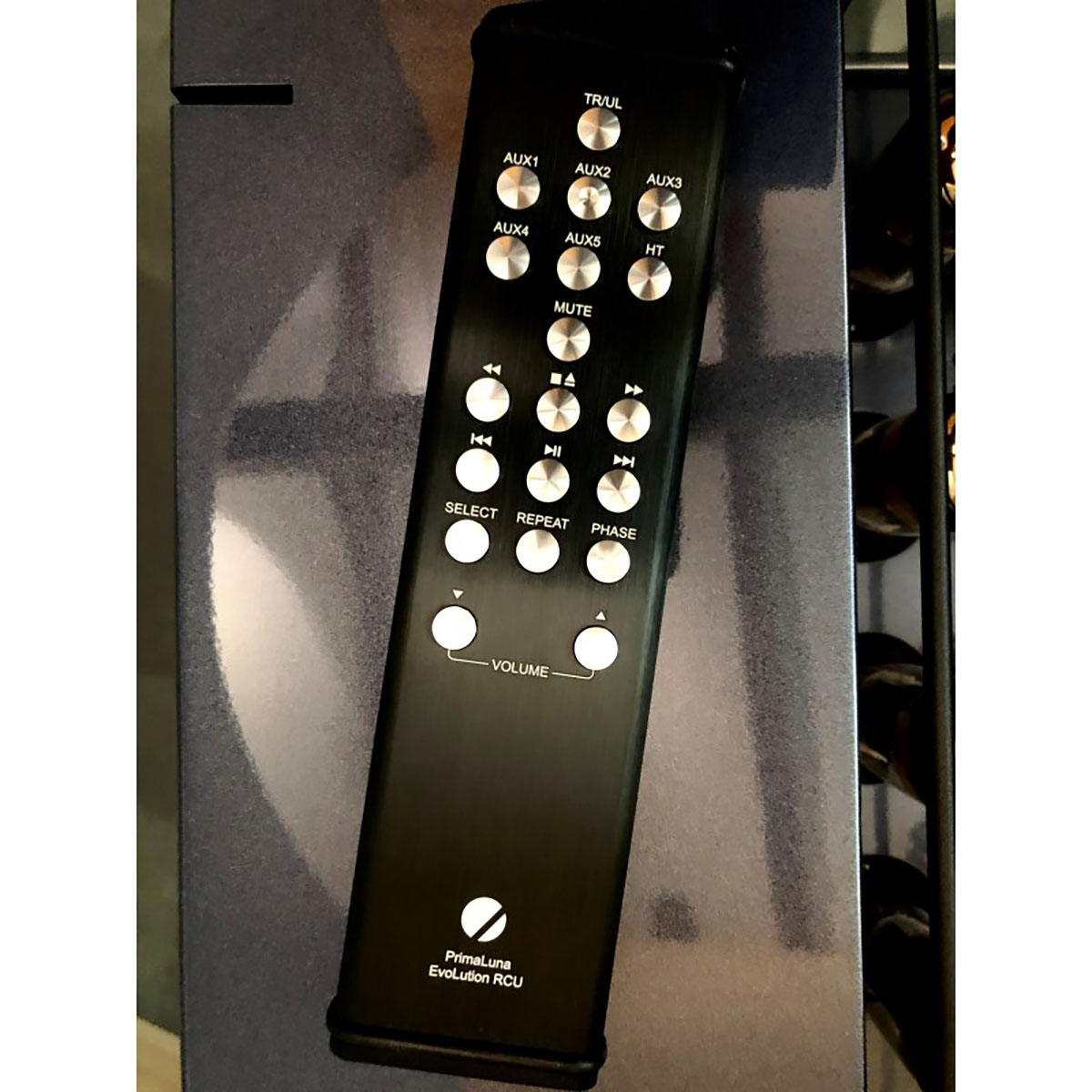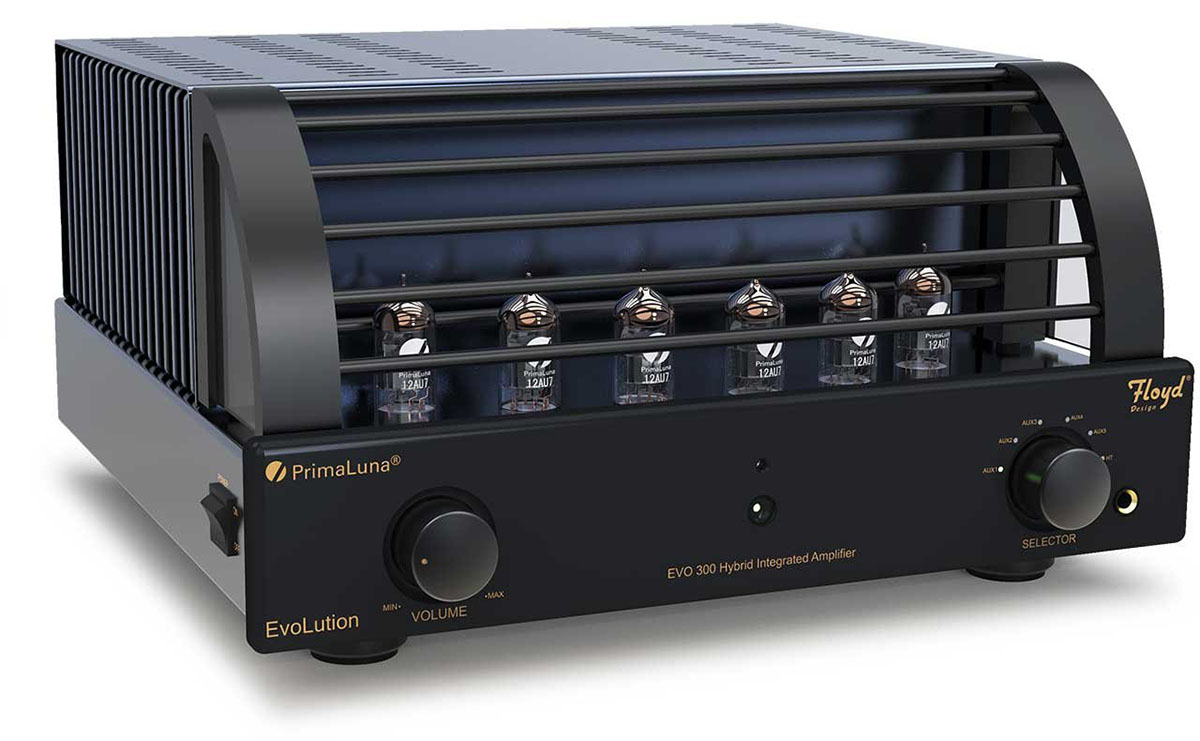For most of that time, they have manufactured all tube designs, and have earned a tremendous reputation in the audiophile community for outstanding price/performance ratios. More recently, PrimaLuna has expanded into the arena of tube/solid-state hybrid amps. The stated goal is to provide the warmth and fidelity of tubes with the gravitas of a well-designed solid-state amp. We are going to put the EVO 300 hybrid integrated amp through a thorough test to find out if they have succeeded.
PrimaLuna EVO 300 Hybrid Integrated Amplifier Highlights
- Preamp gain stage from PrimaLuna EVO 300 Preamplifier
- Dual 12AU7 tubes in the gain stages
- Four 12AU7 driver tubes
- Solid-state output stages with cascading JFETs from Linear Systems
- Custom-designed MOSFETs from Exicon, unique to PrimaLuna
- Low output impedance
- Potted toroidal transformers for true dual mono
- World-class headphone amp
- MOSFET coupled subwoofer output
- Remote control commensurate with a high-end product
The world of audio has seen the evolution of most integrated amplifiers moving from a simple marriage of a pre-amp and power amp into one chassis to having features such as built-in DACS, Wi-Fi capability, Bluetooth connectivity, and room correction software. With the EVO 300 hybrid integrated amp, PrimaLuna has gone back to the concept of a preamplifier and power amplifier in one chassis. In this case, it is a tube preamp stage combined with a solid-state power amp stage. PrimaLuna does not include a DAC nor a phono stage in the EVO 300, as the company thinks one is better off with an external DAC so one does not need to scrap the amp as digital technology changes. PrimaLuna does offer its own DAC, or one can select from the many other units available in the audio world. For the phono stage, the company does offer an add-on phono stage option underneath the amp in its own enclosure to keep noise to a minimum.
The EVO 300 Hybrid Integrated Amplifier offers 100/150 watts per channel into 8/4 ohms. The included remote control offers easy switching between its five pairs of RCA inputs (plus another home theater bypass input), volume control, and even phase switching at the listening position. A remote control rarely deserves recognition, but this remote is so well-built and heavy that it is a component on its own. On the surface, the EVO 300 is a simple product. Under the hood, it is anything but.
Power:
8 Ohms @ 100 watts per channel (0.2% THD)
4 Ohms @ 150 watts per channel (0.2% THD)
Inputs:
5x Stereo RCA
Stereo:
RCA HT Bypass
RCA Tape Out
Outputs:
1 Pair Speaker
RCA:
Stereo/Mono Subwoofer
Headphone:
1/4″ Headphone Port
Frequency Response:
10Hz-80kHz +/- 3dB
Damping Factor:
160
S/N Ratio:
-105dbA
Input Sensitivity:
415mV
Input Impedance:
34kΩ
Power Consumption:
99 watts (no signal in) / 645 watts @ 4R
Standard Tube Complement:
6x 12AU7 (2x Input, 4x Driver)
Dimensions (W x H x D):
15.9″ x 8.1″ x 15.2″
Weight:
68.3 lbs.
MSRP:
$6995.00
Website:
Company:
SECRETS Tags:
PrimaLuna, EVO, 300, Hybrid, Integrated, Amplifier
Secrets Sponsor
It was mentioned earlier in this text that the EVO 300 Hybrid is a simple component in terms of its adherence to the ‘less is more’ philosophy of eschewing extra items like DACs, room correction, etc., in return for less compromise in the overall design. This reviewer highly recommends visiting PrimaLuna’s web page for some educational reading on all the design areas. Space here does not permit doing justice to how much engineering is packed into the EVO 300 Hybrid in its entirety. Let’s look at some highlights.
The preamplifier section is essentially the same as the EVO 300 tube preamplifier, only missing the tube rectification, which the company states is not needed in this application. The EVO 300 tube preamplifier sells stand-alone for $3995, which means the EVO 300 Hybrid adds the 100/160 (@ 8/4 ohms respectively) power amp section for $3000.
PrimaLuna employs point-to-point wiring on all products, including the EVO 300 Hybrid. The entire signal path of the preamplifier is hand-wired with heavy-gauge cable. The preamp section uses Swiss-made, silver-plated, oxygen-free continuous crystal (OCC) copper with a Teflon dielectric in the critical signal path. A total of six 12AU7 tubes are used in the preamplifier section, which puts it into the arena of overkill, a good thing in audio products.
Both the headphone amplifier and subwoofer outputs are MOSFET coupled, rather than the usual line outputs. The advantage here is that headphones and subwoofers get the same sonic signature from the amplifier section as the main speakers. The headphone amplifier can drive almost any headphone with ease, and the subwoofer output claims to offer a much easier integration with the main speakers: we will put this to the test.
There are three toroidal transformers, each enclosed in a metal housing and then potted in a non-microphonic resin to further reduce noise and protect the windings from moisture and deterioration. Instead of simple switching between inputs, PrimaLuna employs relays, with the active relay being closed to provide a lower noise floor than typical switching devices.
These are just a few of the many design features built into the EVO Hybrid 300. This brings to mind a point that should be made. PrimaLuna also has an EVO 300 all-tube integrated amp for $4695, which is $2300 less than the Hybrid 300. This could cause some confusion (although PrimaLuna works only through a quality dealer network to alleviate this). The EVO Hybrid 300 is not merely the solid-state amp version of the EVO Tube 300. As mentioned earlier, the EVO Hybrid 300 is essentially an EVO 300 Tube Preamplifier with a custom-built power amplifier. This power amplifier can drive difficult loads and opens it up to a wider range of loudspeakers.
That power amplifier is unique to the EVO Hybrid 300 and is sophisticated enough to warrant a review of its own. The solid-state output stages use cascading JFETs from Linear Systems and each channel boasts two complementary pairs of MOSFETs from Exicon. These MOSFETs are proprietary to PrimaLuna for this amplifier. The capacitors in the signal path, are cost no object tin-foil caps that are made in Europe.
The total design of the EVO 300 Hybrid gives the feel of a product that was designed to be state of the art at every level, rather than being designed for a certain price point.
The PrimaLuna EVO 300 Hybrid arrived in FedEx/UPS-proof packaging, with not only double boxing but dense shipping foam in each box. When getting review samples in, I always give the shipping address to my Stellantis (Chrysler-Dodge-Jeep-Ram) dealership as it’s much easier for the shipping company in terms of delivery. The EVO 300 is a relatively compact amp, but in the double boxes, my guys at the dealership all guessed it was a medium-sized subwoofer. Kudos to PrimaLuna to make sure everything arrived safely.
The amp took its place with our usual associated gear and cables:
Power Conditioners: Clarus Concerto, Clarus Duet
Power Cords: Clarus Aqua II
Interconnects: Clarus Aqua II XLR Balanced
Speaker Cables: Clarus Aqua II
Source: Yamaha CD-S2100 CD/SACD player
Speakers: Sonus faber Maxima Amator, Diptyque Audio 140 Mark II, Harbeth SHL-5 Plus XD, and the Sonus faber Gravis VI subwoofer (pair)
The setup itself is quite simple, and for this review, all source material was CD or SACD through the Yamaha CD-2100S. PrimaLuna is quite proud of their subwoofer output (as discussed earlier), so the Diptyque 140 Mark II listening sessions will be both with and without the Sonus faber Gravis VI subwoofers engaged.
Sonus faber Maxima Amator speakers:
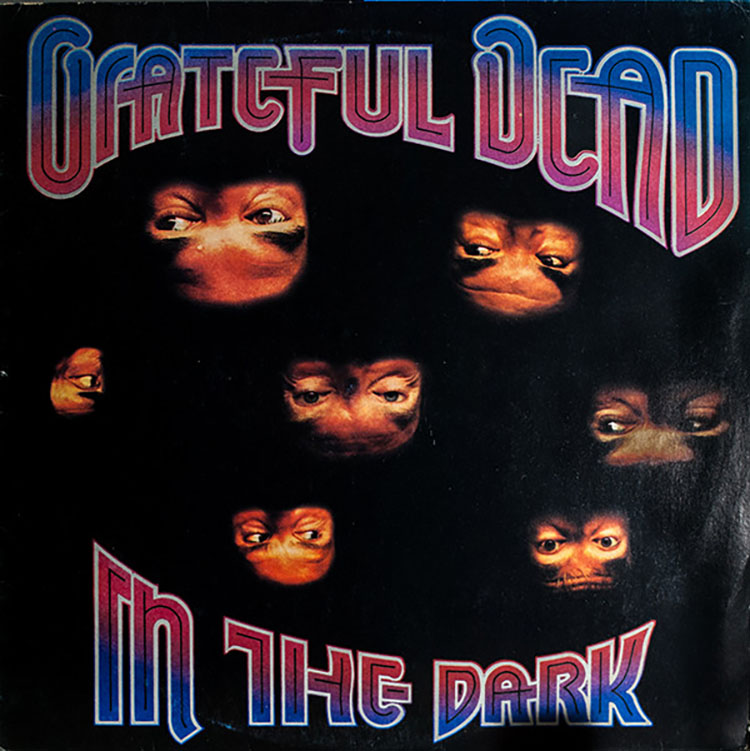
Grateful Dead’s ‘In The Dark’ CD (Arista 1987)
Grateful Dead has a well-established reputation for excellent sound reproduction, especially their live concerts. Their wall of sound from the mid-70s with 28,800 watts of McIntosh power is the stuff of legends. ‘In The Dark’ was selected for the simplest of reasons: it’s known for its excellent sound quality, and I personally have never included it in a review.
‘Touch of Grey’ opens the disc and the exceptionally well-recorded kick drum lays a wonderful foundation for this unusual (for The Dead) hit single. The vocals are distinct, especially the harmonizing from the band. What immediately was noticeable was that the combination of the PrimaLuna EVO 300 Hybrid and the Sonus faber speakers was that one was not taken into an arena. Instead, we were in the recording studio. It was uncanny how perfectly formed all the music was presented. We had a collection of guitars, vocals, drums … etc … all being delivered as one would hear in a recording studio.
This effect was eerily present on ‘Tons of Steel,’ with the train at the beginning of the track coming directly from the left speaker. There was no ‘soundstage’ as one would experience live, as it’s a studio performance. The dynamics were all delivered with ease, and the feeling of a completely silent set of components allowed for micro-dynamics to come through with perfect pitch and clarity. Having owned and enjoyed this disc for over 30 years, it was a new experience to ‘visit’ the musician’s studio. The revelations from ‘In the Dark’ opened up a whole new set of priorities for the next discs: what else can we learn about music reproduction from this amplifier?

Cowboy Junkies ‘The Trinity Session’
After experiencing a normal 1980s studio recording, my thoughts turned to something totally different. In terms of that something different, ‘The Trinity Session,’ recorded with a single microphone at the Church of the Holy Trinity in Toronto, seemed the perfect choice to delve into the abilities of the PrimaLuna amp. This disc is all about subtle music and a slow pace. It’s also about recreating the space of this Anglican church, certainly a challenge for any two-channel system.
‘Trinity’ opens with Margo Timmins’s haunting solo performance of ‘Mining for Gold.’ With a well-matched audio system, one is vaguely aware of a rumbling right before Margo sings to us. This is the furnace of the church, and it is delivered through the EVO 300 Hybrid and those seven-inch woofers in the Sonus faber speakers with such clarity that caused me to be immediately drawn into the performance. Margo’s voice is raw emotion from the beginning of ‘Mining for Gold’ and into track 2, ‘Misguided Angel,’ which is a remarkably intense love song for today’s much wimpier world than it was in 1988. The rest of the family joins in on ‘Misguided Angel,’ with accordion, pedal steel, bass, drums, and mandolin.
I have owned several copies of this disc over the last 30-plus years, and have heard some systems sound mediocre while others have soared as the entire ensemble engages on this track. The PrimaLuna amp brought out every gram (hey, it was recorded in Canada, and they embrace the metric system) of ‘Misguided Angel’ with all the emotion Margot and family put into the song.
‘The Trinity Session’ is an absolute treasure from start to finish, and the EVO 300 Hybrid brings life to the remaining 10 tracks, including ‘Blue Moon,’ 200 More Miles’ and ‘Sweet Jane.’ The recreation of the space was so well rendered by the combination of the EVO 300 Hybrid and Sonus faber speakers that I returned to this disc three more times before doing this portion of the review. The holographic feel of this rather modestly priced amp, and the silent background that it wrapped the music in was nothing short of quiet brilliance. As much as I was loath to do so, it was time for another pair of speakers.
Harbeth SHL5 Plus XD

Star Trek (2009)
The Harbeth SHL5 Plus XD speakers are known for their exceptional clarity with many reviewers finding they lacked dynamics compared to most other speakers in their price range. I found the Cambridge Audio Edge NQ Preamp / Edge W power amp combination quite capable of delivering outstanding macro-dynamics through these British monitors, to the point where regular demonstrations of challenging movie soundtracks have been a regular staple when showing them off.
The EVO 300 Hybrid Integrated Amplifier is close enough in both power ratings (100 WPC @ 8 ohms) and pricing, so putting it to the test with the Harbeth speakers was a natural fit. Reviewer’s note: One would need to add a DAC/Streamer to the PrimaLuna’s $6995 price tag, but then the Cambridge pair is $9998 with DAC/Streamer on board would leave $3000 to add these features to the EVO 300 Integrated to match the price of the Cambridge pair. PrimaLuna makes an excellent DAC, and there are many options for separate DAC/Streamer combos on the market in that $3000 arena. Call it a draw in terms of pricing.
This Star Trek 2009 reboot of the franchise was selected for two reasons. The first was the excellent score by Michael Giacchino, which is present for 45 minutes in this two-hour movie. The second is the exceptionally wide array of sound effects from the chirps of all the technology in this futuristic setting to the extreme challenges of punching into warp drive and exploding ships. If a speaker and amp can do all these things well, it’s a winning combination.
The synergy presented by the OPPO/PrimaLuna/Harbeth trio of components (total retail price about $17,500 including stands or about $24,000 when adding the system upgrading Clarus Power/Cable package) was nothing short of a sonic feast. From the opening score in which Michael Giacchino’s talents combine with Kirk’s father saving his wife and son from the villain Nero’s genocidal plans to the launch of the fleet of Starships to Vulcan, the feeling of space in the caverns on the ice planet on which Spock marooned Kirk all the way to the final scene in which the massive ship which was captained by Nero was destroyed, this relatively benign looking system handled all of it with power, finesse and even ‘oh so close to subwoofer bass.’
Each ship going into warp drive was matched to a punch in the chest, and the EVO 300 Integrated not only hit hard, but it also ‘felt’ as powerful on the Harbeths as did the 500 WPC Michi S5 power amp we have on hand as a reference amp. This brings to mind ‘specmanship.’ The EVO 300 Integrated is ‘only’ rated at 100 WPC into an 8-ohm load. Based on the performance that it delivered in ‘Star Trek,’ it is pretty clear that it has plenty of available power in reserve for peaks. It also brings to mind that 100 watts, done right, is a lot more power than most people think. This is not 100 watts of simple receiver power driving a resistive load. This is a powerhouse of an amplifier that can drive all but a few loudspeakers on the planet to their full potential.
The experience with Star Trek was a sublime escape for two hours of pure music, effects, and even a tremendous plot. The fact that it was rendered so well with two speakers instead of the usual five to seven plus one or two subwoofers speaks volumes (pun intended) about the abilities of the PrimaLuna amp.
Diptyque 140 Mark II Planar Loudspeakers (sans subwoofer)
The third challenge for the PrimaLuna EVO 300 Hybrid Integrated amp was the most difficult test of all: The Diptyque 140 Mark II Planar loudspeakers. The 140 Mark II’s are one of audio’s bargains when fed the right signal. They are a planar speaker that utilizes isodynamic technology to drive large membrane panels in the bass and long, thin tweeter membranes. To energize the bass panels, current is required. The Diptyque towers are almost a perfect match for a high-current amplifier that delivers 100 watts of pure power.

Mighty Sam McClain: Sweet Dreams
This Telarc blues CD is 55 minutes of pure toe-tapping, raw, emotional bliss. Sam’s band has nine players to put his vocals into the proper framing they deserve. The title track, ‘Sweet Dreams,’ opens with drums, Hammond organ, piano and bass. Each is done with perfect pitch through this speaker/amp combination. The sound of the snare’s rim being struck was natural and ‘ultra quick,’ as it should be. The decay was comparable to an actual rim being hit, while the organ, bass, and piano rendered an abundance of ‘you are there’ to the song. Sam’s vocals are robust and emotional, and it was clear on the first few tracks of this disc that this loudspeaker pair and amplifier were made for each other.
‘Learn to Love You Again’ is everything we love about Blues. It’s sad, inspiring, and hopeful for its message of reuniting with his woman. The bass and piano team up with Sam to bring out all the raw feeling he put into this track, and again the PrimaLuna EVO 300 Hybrid amp placed the proper weight and pace into Sam’s voice plus his band. The background was ultra quiet and each instrument was so clear and natural that I was truly bummed out when the 55 minutes were up. The PrimaLuna proved it can deliver delicacy and pace. How can it handle being tortured? Time for a tougher sonic feast.
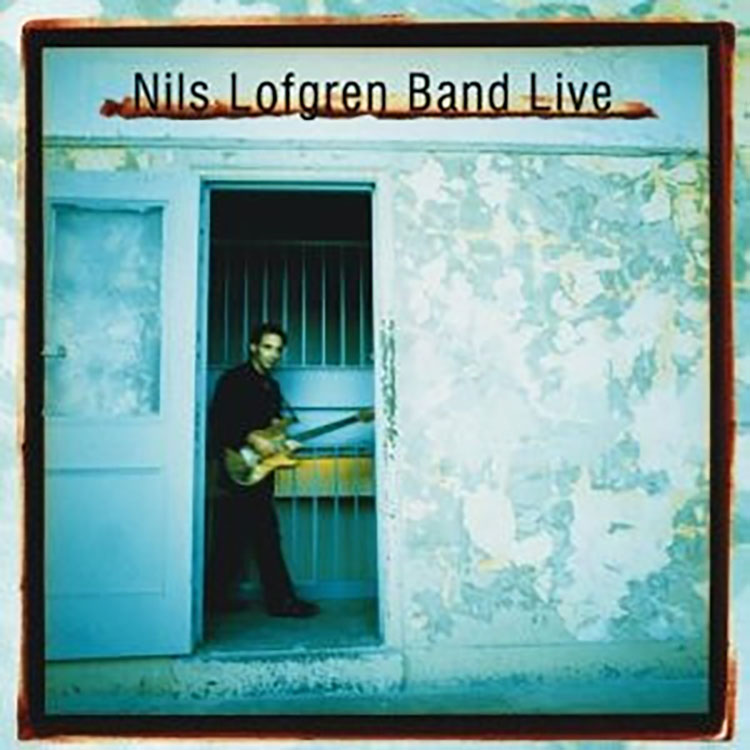
Nils Lofgren Live: Drum and Bass Intro
Anyone who has attended the major audio shows (think AXPONA, Capital Audio Fest, The Munich Show … etc…) has heard this track. It is one of the best methods for discovering how well a system can handle heavy dynamics from its roughly 30 Hz bass floor to the powerful thwacks on drums that require a strong midrange and tweeter to bring out not only the fundamentals but also the harmonics that extend to the tweeter. Contrary to conventional thinking on this track, it’s more than just bass.
The PrimaLuna amp GRABBED the Diptyque planar speakers from the opening guitar strums through the renowned bass taking over and into the drums. The faster drum rolls in the middle of the track were lightning-fast, authoritative, and authentic. The deepest bass notes through this system prove that a Planar speaker CAN deliver deep bass. The EVO 300 Hybrid has power, LOTS of power. The ease with which it energized these speakers with close to subwoofer level bass is ample evidence that PrimaLuna has delivered a $7000 amp that can drive almost anything.
Perhaps you have $30,000 you were planning on spending on a pair of speakers and a pre-amp and power amp. You might be thinking of spending half on each the amp pairing and the speakers. This amp is so good that you might look at speakers for over $20,000 because you are saving on the amp. Call this an option.

Steely Dan 2 against nature: with and without a subwoofer
If you have speakers that are linear down to 35 Hz, you are getting almost all the bass from any musical performance. Years of experience have taught this reviewer that this is the sweet spot for enjoying music and movies without feeling deprived.
Then there is that desire to get that last 1.25 octaves that extend from 35 to 15 Hz. Home theater systems have done this for decades with subwoofers. For many home theater systems, perfect pitch and accuracy take a back seat to raw power.
The PrimaLuna EVO 300 Hybrid Integrated amp and Diptyque 140 Mark II Planar speakers have been delivering that linear bass to 35 Hz, and doing so well that asking for more would be greedy. However, as Gordon Gekko said in Wall Street, ‘greed is good.’ Ok, so he was the bad guy. His character was fun. And we are going to get greedy and find out if the MOSFET coupled subwoofer output to the pair of Sonus faber Gravis VI subwoofers can elevate this system to new heights.
The Gravis VI subwoofers are a sealed design with dual 12-inch drivers in each cabinet. They use Class A/B amplifiers, have their own room correction ability, and are flat to 12 Hz in our listening room. The challenge is for any conventional dynamic woofer to match the speed of the membrane drivers in the Diptyque speakers.
The system set up for this was relatively simple: All features in the Gravis VI are controllable with the well-designed app. This includes setting the phase, low-pass filter (which was set to 40 Hz), and volume. Running test tones at 20 and 50 Hz allowed a simple adjustment of volume on the Gravis VI to level-match them, and we were in business.
Now that the setup was done, it was a simple matter of using the app to instantly engage and disengage the subwoofer from the system while in the listening chair. The speakers were being run at full range and were not affected by the subwoofer’s output.
For the music tracks, ‘Gaslighting Abby’ and ‘Cousin Dupre’ were selected. Both tracks have a synthesized bass drum which reaches 16 Hz. The same drum also hits at 32 and 48 Hz and will sound great on smaller systems. It is only with direct comparisons that one will hear and/or feel the difference.
The MOSFET coupled subwoofer output has the design goal of matching the main speakers to the subwoofer to match how it is done by REL, Sonus faber, and other high-end subwoofer companies who offer a direct conduit from the power amp to the subwoofer using a Speakon style cable. It’s a subtle difference compared to the usual RCA line-level connection, yet it is the only way I have used the Gravis VI subwoofers. They are $15,000 per pair. It’s only sensible to get all the performance that these Italian subs can deliver.
Simply put, the EVO 300 Hybrid knocked this out of the park. Switching the subwoofers in and out during these tracks was immediately noticeable in the bass depth and power. Bass went from punchy to punchy and rippling. It was the type of bass that rolled through your body with a feeling to it. Adding the Gravis VI subwoofers to the Diptyque speakers with this technology the PrimaLuna has elevated the overall performance to state of the art, no compromise, let me get out every challenging disc I own so I can experience it again performance! The subwoofers did not detract at any time, and the whole listening experience proved to this reviewer that PrimaLuna ‘got it right’ by going the extra mile with this subwoofer integration method.
This was the listening session that made it clear that one could get an absolute giant killer system for about $50,000. Here we have a $7000 amp, $17,000 in speakers, $15,000 in subwoofer, $3500 in an SACD deck, and $8000 in cables/power cord that delivers bass from 12 Hz and up, a see-through midrange, soaring highs, and an overall experience that could easily set one back multiple of six digits of hard earned dollars to match.
This $7000 PrimaLuna amp would be quite happy to be the anchor of this $50,000 system.
Secrets Sponsor
Let’s put that headphone amp to the test.
PrimaLuna went to the same lengths with the headphone output as it did with the subwoofer output (both discussed earlier in this review). In essence, the MOSFET power amp section is driving the headphones. As of this review, we only have a pair of Grado SR80x headphones (MSRP: $125) on hand for this portion of the review, but as budget cans go, the Grados have some serious performance. I got them for casual listening when I don’t want to bother others with my music playing. They have been a welcome respite after some long days, and jazz on them with a good cigar and cocktail can take the edge off that day.

Roger Waters, “In The Flesh”
The first disc I fired up was Roger Water’s Live “In The Flesh” SACD. It is a favorite of mine with all the sonic spectaculars, soaring guitars, amazing female vocals, and deep bass. Keeping in mind my usual systems are Legacy Focus XD, Diptyque 140 Mark II’s and a Sonus faber Gravis VI subwoofer or Harbeth SHL5 Plus XD and a pair of MJ Acoustics Kensington subwoofers. In other words, I am used to incredibly well-played music with bass to below 20 Hz.
The Grados went from pleasant headphones using Dayton Audio headphone amp to “they can’t be this good” from the PrimaLuna. Bass was present, punchy, and deep. The vocals came into much better focus, and everything was better. The “Deity is playing” guitar solo in ‘Shine On You Crazy Diamond’ was powerful and emotional. At this point, I had to get more.
Next up was a second go at ‘The Trinity Session’ as mentioned earlier in the review. Margot’s voice sounds eerie centered between one’s temples, but in a good way. The disc in its entirety was pure joy to experience. The hours I got to spend with the headphone amp caused me to start looking into higher- end cans knowing there are headphone amps such as the one built into the EVO 300 Hybrid. To headphone enthusiasts: it can drive almost any headphone system you can purchase.
PrimaLuna’s EVO 300 Hybrid Integrated Amplifier is a state-of-the-art amplification system that does more than expected for an investment that is less than expected.
- Tube preamp section
- Class A/B solid state power amp section
- Power delivery that defies mere specs
- Highest quality parts throughout the amp
- No need for interconnects from preamp to power amp
- Transformer coupled subwoofer and headphone output
- Looking at the soft glow of tubes while listening to music
- What this amp does with every speaker
- Remote control so heavy it could be a weapon
- More recommended systems that combine PrimaLuna components for people who don’t have a local dealer
PrimaLuna’s goal with the EVO 300 Hybrid Integrated amplifier was to bring to the audio world one component that could take a basic signal from one’s turntable/phono pre-amp, SACD/CD player, or streamer/DAC and deliver it to the main speakers without noise or compromise.
They have done so with room to spare. Every performance through every speaker (and I also tried this amp with a pair of $3000 DALI Oberon 9’s, a pair of $9500 Heretic AD-612, and a pair of $9000 Vaughn Line Array Major/$8000 pair of MJ Acoustic Kensington subwoofers, all with equally excellent results) was musical and listenable. Several times, the thought hit that it was going to be a sad day when this amp had to go back to PrimaLuna. It is more than an outstanding amplifier. The PrimaLuna EVO 300 Hybrid Integrated Amplifier can be the hub of one’s music system for decades to come. This amplifier will be sorely missed.




